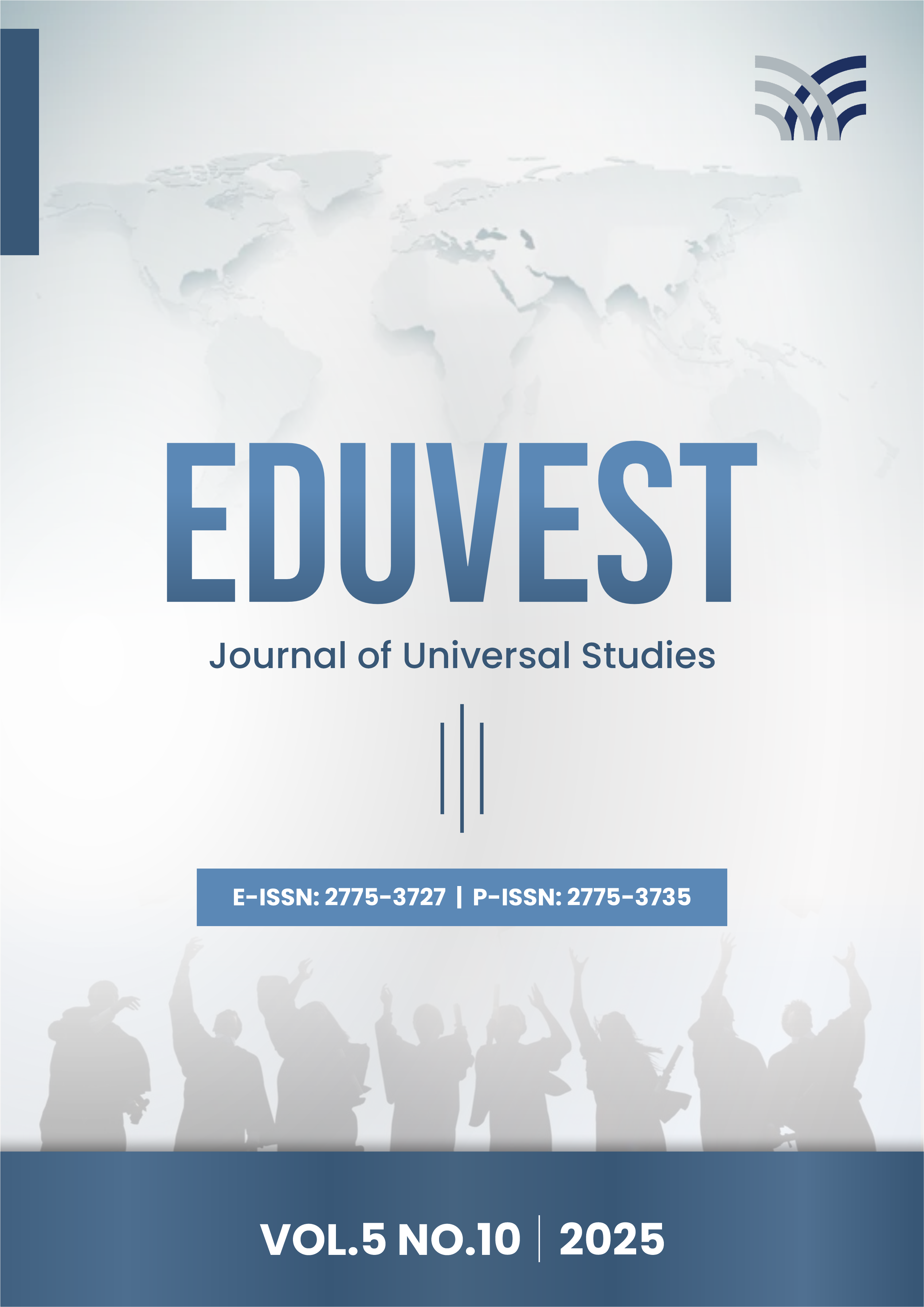Ergonomic Risk Mitigation in Batik Stamping: A Hierarchical Task Analysis and REBA Study at Batik Komar Bandung
DOI:
https://doi.org/10.59188/eduvest.v5i10.51226Keywords:
Ergonomics, HTA, REBA, Postural Risks, Batik Stamp WorkersAbstract
This research investigates postural risks faced by batik stamp workers at Batik Komar Bandung, employing Hierarchical Task Analysis (HTA) and Rapid Entire Body Assessment (REBA) to assess worker ergonomics. While batik holds immense cultural value, there is a lack of ergonomic research focusing on the well-being of workers in traditional batik production. The case study at Batik Komar Bandung involved 11 workers aged between 20 to 50 years, where work activities were documented through video and photographs, followed by HTA task analysis and REBA postural risk assessment. The findings reveal that the stamping stage, which constitutes 86.85% of the process, presents significant ergonomic risks, with a REBA score of 10 indicating high postural risk. Workers frequently use a ±1.1 kg stamp while maintaining bent postures for prolonged periods, contributing to potential musculoskeletal disorders. These findings underscore the urgent need for ergonomic interventions within the batik industry. The study proposes potential solutions, including workstation redesign, tool modification, and the implementation of regular rest periods to mitigate health risks. By addressing the ergonomic challenges in traditional batik production, this research highlights the importance of worker well-being and sustainability in the batik industry. Additionally, the study demonstrates the practical application of HTA and REBA in identifying postural risks and formulating effective interventions, contributing valuable insights to the growing field of ergonomic research in cultural industries.
References
Ahdiat, A. (2022). Usaha Batik Indonesia Mayoritas Berskala Mikro Demografi. Databoks. https://databoks.katadata.co.id/datapublish/2022/10/02/usaha-batik-indonesia-mayoritas-berskala-mikro
Anugraha, R. A., Sutan, W., & Mufidah, I. (2015). The Design of Batik Stamp tool Scraping Working Table Using Ergonomics Principles. Procedia Manufacturing, 4(Iess), 543–551. https://doi.org/10.1016/j.promfg.2015.11.074
Artiwi, A., & Widyastuti, T. (2021). Perancangan Batik Cap Dengan Corak Wedangan Tradisional Indonesia. Hastagina: Jurnal Kriya Dan Industri Kreatif, 1(02), 77–86. https://doi.org/10.59997/hastagina.v1i02.782
Bevan, S. (2015). Economic impact of musculoskeletal disorders (MSDs) on work in Europe. Best Practice & Research Clinical Rheumatology, 29(3), 356–373. https://doi.org/10.1016/j.berh.2015.08.002
CHANG, W. S., BEJJANI, F. J., CHYAN, D., & BELLEGARDE, M. (1987). Occupational musculoskeletal disorders of visual artists A questionnaire and video analysis. Ergonomics, 30(1), 33–46. https://doi.org/10.1080/00140138708969675
Das, S., & Natarajan, S. (2022). A study on musculoskeletal disorders in garment industry. Tekstilna Industrija, 70(2), 61–66. https://doi.org/10.5937/tekstind2202061D
Fitrianingrum, D. (2023). Faktor yang Berhubungan dengan Keluhan Musculoskeletal Disorders pada Pekerja Batik Cap. Jurnal Penelitian Dan Pengembangan Kesehatan Masyarakat Indonesia, 4(1). https://doi.org/10.15294/jppkmi.v4i1.66757
Gallagher, S., & Marras, W. S. (2012). Tolerance of the lumbar spine to shear: A review and recommended exposure limits. Clinical Biomechanics, 27(10), 973–978. https://doi.org/10.1016/j.clinbiomech.2012.08.009
Gellman, M. D., & Turner, J. R. (Eds.). (2013). Encyclopedia of Behavioral Medicine. Springer New York. https://doi.org/10.1007/978-1-4419-1005-9
Hodgkinson, G. P., & Crawshaw, C. M. (1985). Hierarchical task analysis for ergonomics research. Applied Ergonomics, 16(4), 289–299. https://doi.org/10.1016/0003-6870(85)90094-8
McAtamney, L., & Hignett, S. (2004). Rapid Entire Body Assessment. In Handbook of Human Factors and Ergonomics Methods (pp. 97–108). CRC Press. https://doi.org/10.1201/9780203489925-17
McDermott, F. T. (1986). Repetition strain injury: a review of current understanding. Medical Journal of Australia, 144(4), 196–200. https://doi.org/10.5694/j.1326-5377.1986.tb128357.x
Meher, A. K., & Panda, P. K. (2024). The Employment and Livelihood Challenge Among the Informal Handloom Weavers During COVID-19 and Lockdown in Odisha, India. Management and Labour Studies. https://doi.org/10.1177/0258042X241238819
Ncube, F., Kanda, A., & Chirengendure, Y. (2019). An evaluation of ergonomic risks associated with tailoring tasks using the rapid entire body assessment method. International Journal of Human Factors and Ergonomics, 6(2), 124. https://doi.org/10.1504/IJHFE.2019.102297
Oakley, P. (2004). Low back disorders: evidence-based prevention and rehabilitation. Journal of Manipulative and Physiological Therapeutics, 27(1), 77. https://doi.org/10.1016/j.jmpt.2003.11.020
Prabarukmi, G. S., & Widajati, N. (2020). The Correlation of Ergonomic Risk Factor with Musculoskeletal Complaints in Batik Workers. The Indonesian Journal Of Occupational Safety and Health, 9(3), 269. https://doi.org/10.20473/ijosh.v9i3.2020.269-278
Promann, M., & Zhang, T. (2015). Applying Hierarchical Task Analysis Method to Discovery Layer Evaluation. Information Technology and Libraries, 34(1), 77–105. https://doi.org/10.6017/ital.v34i1.5600
Shamsuddin, K. A., Che Ani, M. N., Ab-Kadir, A. R., & Osman, M. H. (2014). Analysis on the Work-Related Musculoskeletal Disorders (WMSD’s) Based on Ergonomic Study in Case of Industry Study. International Journal of Engineering Research, 3(4), 190–195. https://doi.org/10.17950/ijer/v3s4/401
Shepherd, A. (1985). Hierarchical Task Analysis and Training Decisions. PLET: Programmed Learning & Educational Technology, 22(2), 162–176. https://doi.org/10.1080/1355800850220209
Siregar, A. P., Raya, A. B., Nugroho, A. D., Indana, F., Prasada, I. M. Y., Andiani, R., Simbolon, T. G. Y., & Kinasih, A. T. (2020). Upaya Pengembangan Industri Batik di Indonesia. Dinamika Kerajinan Dan Batik: Majalah Ilmiah, 37(1). https://doi.org/10.22322/dkb.v37i1.5945
Spallek, M., Kuhn, W., Uibel, S., van Mark, A., & Quarcoo, D. (2010). Work-related musculoskeletal disorders in the automotive industry due to repetitive work - implications for rehabilitation. Journal of Occupational Medicine and Toxicology, 5(1), 6. https://doi.org/10.1186/1745-6673-5-6
Suharto, Suryanto, Priyo, V. T., Sarana, Hermawan, I., & Suwondo, A. (2014). Bahan Alternatif Pembuatan Canting Batik Cap (CBC). Prosiding SNST, 25–31.
Sumardiyono, Chahyadhi, B., Suratna, F. S. N., Fauzi, R. P., Wijayanti, R., Widjanarti, M. P., & Ada, Y. R. (2023). Strategi Mengurangi Gangguan Muskuloskeletal Pembatik Tulis Melalui Kursi Ergonomis. Jurnal Abdimas Ilmiah Citra Bakti, 4(3), 522–541. https://doi.org/10.38048/jailcb.v4i3.2018
Trixie, A. A. (2020). Filosofi Motif Batik Sebagai Identitas Bangsa Indonesia. Folio, 1(1), 1–9.
Widyaningtyas Savitri, I., Hardian, & Ayu Sumekar, T. (2015). Hubungan Antara Aktivitas Membatik Dengan Gangguan Sistem Muskuloskeletal Pada Pengrajin Batik Tulis. Media Medika Muda, 4(4), 986.
Downloads
Published
How to Cite
Issue
Section
License
Copyright (c) 2025 Yosua Novalesi, Yannes Martinus Pasaribu, Etika Vidyarini

This work is licensed under a Creative Commons Attribution-ShareAlike 4.0 International License.











